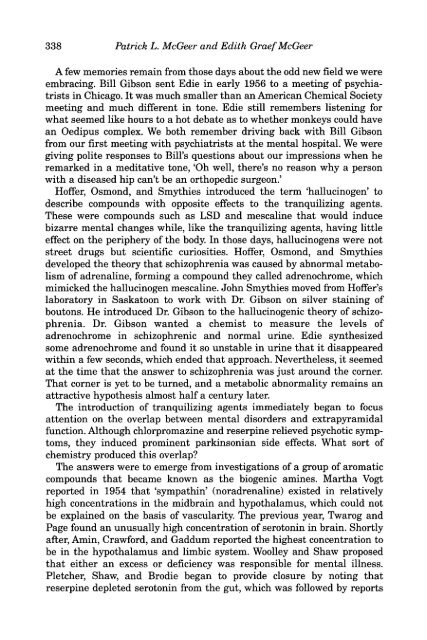Edith Graef McGeer - Society for Neuroscience
Edith Graef McGeer - Society for Neuroscience
Edith Graef McGeer - Society for Neuroscience
Create successful ePaper yourself
Turn your PDF publications into a flip-book with our unique Google optimized e-Paper software.
338 Patrick L. <strong>McGeer</strong> and <strong>Edith</strong> <strong>Graef</strong><strong>McGeer</strong><br />
A few memories remain from those days about the odd new field we were<br />
embracing. Bill Gibson sent Edie in early 1956 to a meeting of psychiatrists<br />
in Chicago. It was much smaller than an American Chemical <strong>Society</strong><br />
meeting and much different in tone. Edie still remembers listening <strong>for</strong><br />
what seemed like hours to a hot debate as to whether monkeys could have<br />
an Oedipus complex. We both remember driving back with Bill Gibson<br />
from our first meeting with psychiatrists at the mental hospital. We were<br />
giving polite responses to Bill's questions about our impressions when he<br />
remarked in a meditative tone, 'Oh well, there's no reason why a person<br />
with a diseased hip can't be an orthopedic surgeon.'<br />
Hoffer, Osmond, and Smythies introduced the term 'hallucinogen' to<br />
describe compounds with opposite effects to the tranquilizing agents.<br />
These were compounds such as LSD and mescaline that would induce<br />
bizarre mental changes while, like the tranquilizing agents, having little<br />
effect on the periphery of the body. In those days, hallucinogens were not<br />
street drugs but scientific curiosities. Hoffer, Osmond, and Smythies<br />
developed the theory that schizophrenia was caused by abnormal metabolism<br />
of adrenaline, <strong>for</strong>ming a compound they called adrenochrome, which<br />
mimicked the hallucinogen mescaline. John Smj^hies moved from Hoffer's<br />
laboratory in Saskatoon to work with Dr. Gibson on silver staining of<br />
boutons. He introduced Dr. Gibson to the hallucinogenic theory of schizophrenia.<br />
Dr. Gibson wanted a chemist to measure the levels of<br />
adrenochrome in schizophrenic and normal urine. Edie synthesized<br />
some adrenochrome and found it so unstable in urine that it disappeared<br />
within a few seconds, which ended that approach. Nevertheless, it seemed<br />
at the time that the answer to schizophrenia was just around the corner.<br />
That corner is yet to be turned, and a metabolic abnormality remains an<br />
attractive hypothesis almost half a century later.<br />
The introduction of tranquilizing agents immediately began to focus<br />
attention on the overlap between mental disorders and extrapyramidal<br />
function. Although chlorpromazine and reserpine relieved psychotic symptoms,<br />
they induced prominent parkinsonian side effects. What sort of<br />
chemistry produced this overlap?<br />
The answers were to emerge from investigations of a group of aromatic<br />
compounds that became known as the biogenic amines. Martha Vogt<br />
reported in 1954 that 'sympathin' (noradrenaline) existed in relatively<br />
high concentrations in the midbrain and hypothalamus, which could not<br />
be explained on the basis of vascularity. The previous year, Twarog and<br />
Page found an unusually high concentration of serotonin in brain. Shortly<br />
after, Amin, Craw<strong>for</strong>d, and Gaddum reported the highest concentration to<br />
be in the h3rpothalamus and limbic system. WooUey and Shaw proposed<br />
that either an excess or deficiency was responsible <strong>for</strong> mental illness.<br />
Fletcher, Shaw, and Brodie began to provide closure by noting that<br />
reserpine depleted serotonin from the gut, which was followed by reports











![[Authors]. [Abstract Title]. - Society for Neuroscience](https://img.yumpu.com/8550710/1/190x245/authors-abstract-title-society-for-neuroscience.jpg?quality=85)





